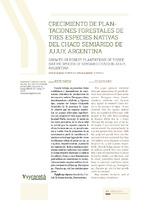Crecimiento de plantaciones forestales de tres especies nativas del Chaco semiárido de Jujuy, Argentina
Growth of forest plantations of three native species of semiarid Chaco in Jujuy, Argentina
Abstract
En este trabajo, se presentan datos estadísticos y dasométricos de crecimiento obtenidos de plantaciones de tres especies nativas Pterogyne nitens, Anadenanthera colubrina y Tipuana tipu, propias del Bosque Chaqueño Semiárido de la provincia de Jujuy. Se observó que las especies estudiadas no poseen diferencias significativas con respecto al IMA según test de Kruskal Wallis (α=0,05). A través de los datos promedios de la altura total se calculó que las especies superan la altura de ramoneo en un periodo mayor a 6 años. Con la proyección de su crecimiento a partir de modelos no lineales se estimó que lograrán los 10 cm de diámetro altura al pecho en 22, 14 y 15 años, respectivamente. A pesar de ser especies de lento a mediano crecimiento pueden conformar una unidad de domesticación destinada a madera de calidad y leña, y crear forestaciones productivas en condiciones de semiáridez en donde especies exóticas de rápido crecimiento (Pinus sp., Eucaliptus sp., Populus sp., etc.) no podrían prosperar. This paper presents statistical data and mensuration of growth derived from plantations of three native species: Pterogyne nitens, Anadenanthera colubrina and Tipuana tipu, typical of semiarid Chaco forest in the province of Jujuy. It was observed that the species studied have no significant differences with respect to the AMI IMA according to Kruskal Wallis test (α = 0.05). Through the average data of the total height, it was calculated that the species exceed the grazing height in a period greater than six years. With the projected growth from non-linear models it was estimated that they will achieve 10 cm diameter at breast height in 22, 14 and 15 years, respectively. Despite being species of slow to medium growth they may constitute a unit of domestication destined to quality timber and firewood, and to create productive forest plantations in semi-arid conditions where exotic species (Pinus sp., Eucalyptus sp., Populus sp., etc.) of fast growth could not succeed
URI
https://hdl.handle.net/20.500.12219/2695http://www.yvyrareta.com.ar/index.php/component/k2/item/4-crecimiento-de-plantaciones-forestales-de-tres-especies-nativas-del-chaco-semiarido-de-jujuy-argentina
Collections
- Revista Yvyraretá [360]
The following license files are associated with this item:




